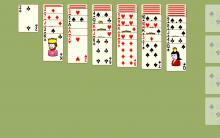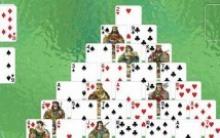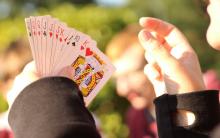A deck of 36 cards is used and two to four players are involved. Each is dealt 6 cards, the next card after the deal is revealed, and its suit sets the trump card for this game.
The object of the game is to get rid of all cards. The last player who does not get rid of the cards remains in the "fools".
The player with the lowest trump card goes first, then clockwise.
You can move any number of cards of the same rank.
The player who is being played can “transfer” or “cover” the cards.
In the first round, cards cannot be transferred. The first "retreat" is 5 cards.
How to translate
If a player has a card of the same value, then he can put it next to an already lying card and "transfer" both cards to the next player. The first horse cannot be transferred. Translation is possible only when the player has not yet begun to fight back. You can re-translate. If at least one turn card is beaten, the others cannot be transferred. You cannot transfer more cards than the next player has in hand. When the cards are transferred to a player who cannot transfer them further, he becomes the beating player, and must cover everything, or accept.
The player can translate the move, but is not obliged. Translation is possible only when the player has not started to fight back.
How to fight back
You can fight back with the highest card of the same suit, or with a trump card, if the hidden card itself is not a trump card - in this case, it can only be covered with the highest trump card.
How to pop up
The walking player has the right to "throw" cards that match the value of any card on the table, including those that were played and those with which they were wings.
If more than two players participate in the game, then the player who played has the first word, but when he started to move, the other players have the right to throw their cards according to the same rules. You can also throw cards when the player has decided to accept the cards and not continue to fight back, this is called "after". You cannot throw more cards than the beating player has left - that is, if the player has three cards, he was given one, and he decided not to cover it, then he can only add two after. You cannot throw more than six cards in total, even if the player has more cards in his hand.
If the player, under whom they move, fought back, then he goes next, but first all players get up to 6 cards, starting with the player who played first, and ending with the player who fought back.
If the player could not fight back, then he takes all the cards, and the player on the left goes next.
Muhlezh and antimuhlezh
You have the opportunity to cheat in the game by purchasing a special gaming gadget. The card game becomes even more realistic: as in real life, if you have a gadget, you can beat off and transfer with any card by pressing the "cheat" button.
The essence of playing the fool is to fold the cards first. The one who is the last with the cards is considered a loser and, accordingly, a fool.
For this card game, a standard deck from six to ace without jokers is used. Initially, each player is dealt six cards. The next one turns over (it is her suit that is considered trump), the rest of the deck is located on top.
Basic rules - the trump card beats any suit, within the same suit the standard ranking is applied. If there is no way to beat the opponent thrown, everything is taken into your hands. In this case, the player misses his turn.
You cannot look at the cards of other players. But you need to make sure that no one can pry, because it is so interesting to know who has which suits.
As long as there is a deck, it is necessary to get a hand to six after each move. The last trump card is taken, after which the game continues until the loser is determined.
Differences in the rules of playing the fool for 36 and 54 cards
The method described above is considered classic. A deck of 36 cards is used for it. However, some craftsmen also use a deck of 54 cards. In this case, the face value from two to five is added, as well as two jokers.
The role of jokers is determined by the players themselves. There are two options:
- even a trump card can beat;
- abilities are divided according to color: black beats black suits, red beats red ones.
In the event that the joker has a trump card, it is played without any trump cards at all - only the seniority of the denominations is preserved.
Some players do not like these additions, so from the standard 54-card decks are drawn by jokers. The rules remain the same.
The specifics of the rules of the game of the translated fool
The Fool is so popular that there are many variations of this game. Some are very popular, others are used only in narrow circles.
Among the most famous is the translation variation. In this case, the player has the opportunity to pass the cards to the next one and thereby protect himself from the need to fight back.
This can be done by seniority. The suit does not matter. However, you cannot:
- translate the first round;
- transfer more cards than the next player has;
- translate the move if there is a trump card on the table (with the agreement of the players, this rule can be omitted).
The rest of the rules are no different from the classic fool. The only thing is that if you have a trump card in your hands, you can not put it, but just show it. In this case, it is called a "pass".
It is worth highlighting the specifics of playing a translated fool, depending on the number of players:
- in a two-player game, the need to fight off passes from one player to another. Everything is simple here and no additional rules are required;
- in a three-player game, the move goes in a circle. If the game is not played as a throwing fool, then the initiator of the move can no longer throw, and this is done by the player who translated;
- when playing four or, as they say, two by two, it is worth considering the presence of teams. If all players have cards, the principle of transferring the move remains the same. However, if the next player in order threw off everything, then the move is transferred after two, that is, skipping the player who left and the next.
Features of the rules of the game of a throw-in fool
Another popular variation of the game is the throw-in fool. Its peculiarity lies in the fact that all players can take part in the course.
In the classic version, the move is played only between two neighboring players: one throws up, and the other fights back. Throwing a fool implies the ability to throw other players.
In this case, there are a number of rules:
- toss can only be done when the player who made the move will no longer toss;
- is thrown clockwise, that is, the batter's neighbor starts to throw up first.
At the same time, the game of three and four is slightly different. The two-by-two and three-by-three scheme implies that only members of one team are throwing.

How to learn to play the fool correctly
Although this game is considered one of the easiest, there are a number of tricks to quickly learn how to win. Some people manage to become masters very quickly from scratch.
It is extremely useful to calculate the opponent's playing style. It is important to know in advance what the enemy will do in a given situation - this way you can play much more confidently and not lose. There are several basic behavioral types:
- collector of trump cards - the player tries to accumulate the maximum of trump cards, does not use them, is engaged in dropping "ballast";
- a collector of large suits - tries to collect more aces, kings, queens, in a word, suits of a large denomination, his goal is to hold out until the end of the game and set the enemy with heavy artillery;
- attacking with a trifle - gives out combinations of several small suits, trying to heap the enemy at the very beginning of the game, takes the initiative of the game into his own hands;
- collector of pairs - trying to collect a pair in order to further use it for attack or defense.
Based on what style of play the opponent uses, you can choose your own defense method and look professional. So, to deal with the collector of trump cards, it is worth determining which suit he has is weak. This will allow you to attack your opponent, "knocking out" his trump card.
To beat a collector of large suits, you should choose a slightly different approach - you just have to try to knock out all the big cards from him.
In order not to be defeated by the attacker with a trifle, it is worth fighting back with large suits - so he will not have the opportunity to throw something at you. From the middle of the game, fire up his weapon against himself - it will be good to attack him with a trifle.
The hardest opponent is the pair collector. He is strong not only in attack, but also in defense. It is best to adopt the same tactics so that you can even the odds. By the way, it is this tactic that allows you to almost always win.

What is a Japanese fool? rules
Separately, it is worth highlighting a simple Japanese variety - "peaks by spikes". The peculiarity of the game is that the spades suit has a special status. You can only beat such a card with spades. If the trump card turns out to be of this suit, then the game is played without the trump cards.
The ranking within the suit is different. The lady is considered the oldest. She can beat a card of any value.
There are also other varieties of the common fool by country:
- czech;
- chinese;
- french;
- polish;
- armenian;
- american.
There is also a variation called "round fool" (also called circular). Its difference from the classic one is that after each move the players exchange their cards clockwise. This greatly complicates the game, but makes it possible to calculate the further actions of the players.
The specifics and rules of playing the fool a couple for a couple
A two-on-two game is a team variation. The essence of the double fool is that the players are divided into two teams, through one. That is, the players sitting opposite belong to the same team.
The 2 by 2 scheme is distinguished by the need to worry not only about yourself, but also about the other player. It is forbidden to toss with your own people, and also to walk on your own
A similar principle of working in pairs is applicable for games of three, four, five. Only the number of players in one team changes.

Rules for playing the fool with epaulets
Another fun variation is the epaulette game. Shoulder straps are sixes that remain at the end of the game. If the loser accepts them on the last move, then it is considered that he received shoulder straps.
In this case, it does not matter whether you play with jokers or not, as well as with what trump cards the game is being played.
The nuances of the rules of the game at the first lights out
There are certain restrictions on the first lights out of the game. They are standard and can be adjusted by agreement of the game participants.
The first rebound means the first move. It is prohibited:
- transfer of the move to another participant;
- tossing more than five cards.
Many participants argue about how many cards can be thrown at the first lights out. If the players cannot come to a consensus, then this rule is omitted. However, such situations are extremely rare.
It is also worth highlighting the distribution of the last cards in the deck. If there are not enough cards for all players to get a hand of six, then the remainder is distributed equally.
The game uses a deck of 36 cards (card rank according to seniority: from ace to six) and involves 2 to 6 players. Each is dealt 6 cards, the next card is revealed and its suit sets the trump card for this game. The rest of the deck is placed on top (closed side), so that the trump card is visible to everyone.
The object of the game is to get rid of all your cards. The last player who does not get rid of the cards remains in the "fools".
In the first deal, the player with the lowest trump card moves (attacks) first; in further deals they play "out of the fool" (player on the left).
The move is always to the left, and consists of laying out one or more cards, and the player's attempts to cover them either with the highest card of the same suit, or with a trump card, if the card being covered is not a trump card itself - in this case, it can be covered only the highest trump card. If the player, under whom they are going, fought back, then the next move goes to him, but first all players get up to 6 cards, starting with the player who played first and ending with the player who fought back. If the player could not fight back, then he takes all the cards, and the next move is followed by the player on the left.
With the participation of four or six players, a 2x2 or 3x3 game is possible, when the players sitting across one are partners and do not go under each other.
The main varieties of the card game for the fool: simple, throw-in and transfer.
Simple Fool
You can move with one card, or with two cards of the same rank. Regardless of whether the card (or cards) is covered, you cannot add cards, the turn ends.
Throw-in Fool
You can move any number of cards of the same rank. The player, under whom the move (the bouncer), can cover the cards, or can accept. The attacking player has the right to throw cards that match any card on the table (which he played and / or which his wings).
If more than two players participate in the game, then the player who moved has the first word, but when he has finished walking, the other players have the right to throw their cards according to the same rules.
You can also flip cards when the player has decided to accept the cards and not continue to fight back (after).
Limitations when flipping cards:
- you cannot attack with more cards than the defender has (if the player has three cards, he was put one, and he decided to accept it, then he can only add two after him)
- you can not throw more than five cards, even if the player has more cards in his hands, that is, the total number of cards for discarding is six
- at the first release, you must not throw more than four cards to the batter.
Transferable fool
The rules are the same as in the flip one, but with one complication: if the player being moved under has a card of the same value, then he can put it next to an already lying card and "transfer" both cards to the next player. The first horse cannot be transferred. Can be re-translated if the next player also has a card of the same rank. You cannot transfer more cards than the next player has in hand. When the cards are transferred to a player who cannot transfer them further, he becomes the beating player, and is obliged to cover everything or accept. Further, the game completely coincides with a throw-in fool.
In addition, there is the concept of "travel card", a special rule of transfer applies when translating with a trump card, for this it is not necessary to put it on the table, it is enough just to show it. This rule is valid only once during a round. If the player using the pass is transferred for the second time during the round, then for the second transfer the trump card must be laid out on the table.
When playing the fool 2x2 or 3x3, the rules are the same. In this case, when one of the players ends the game, the direction of the transfer does not change, that is, when playing clockwise, the transfer is carried out strictly to the player on the left. In case the player on the left no longer has cards, the transfer is made to the next player of the opposite team, who is on the left. Similarly, if a player of any team ends the game with a rebound, the player of the same team has a move clockwise.
The Fool card game is considered the most popular on the territory of the former USSR. Time decided to conceal the name of its author, but it is believed that it appeared in the 19th century in Russia. The aristocracy was skeptical about the new entertainment. But the common people liked it. This explains the colloquial name: lost - it means, "remained in the fools." In the Soviet Union, its popularity increased even more. And the rules in the game "Fool" began to be supplemented. So, along with the classic version, new varieties began to arise.
Basic game features
Despite the huge number of varieties of the game (and there are more than 50), they mostly obey the general rules. Usually a deck of 36 cards is used, sometimes - of 52 (54 without two jokers). The task of each participant is to get rid of all cards before the opponents. Whoever stays with the cards is a "fool" (just don't be offended, here it's just a joking expression).
Now let's look at the basic rules of the "Fool" game. At least two, maximum six people play cards. Each must have 6 cards in their hands. The top (less often - bottom) card of the deck is revealed, this is a trump card. This suit takes precedence over the others. If six players take part, then the whole deck is dealt, and the last card is appointed trump. Traditionally, the loser is appointed as the distributor, and for the first time he is determined by lot.
Simple "Fool"
The rules in the game "Fool" are quite simple. The player with the lowest trump goes first. If this suit is not on hand, they decide on the lowest card. When there are more than two players, they walk clockwise, that is, to the one sitting on the left. He lays down one or two cards of the same value. The second player must fight them off. This means that he can cover them with a card of the same suit, but higher in value, or a trump card. A trump card can only be beaten by a trump of greater significance. If the cards are discarded, they are discarded, and they are not used until the end of the game. It is forbidden to open a retreat to find out which cards are already out of play. If the player could not or did not want to beat off the move, he takes all the cards from the stake - these are the rules in the game "Fool".

Then the players draw cards from the deck up to six. As a rule, the one who walked takes the first, then the rest of the participants clockwise. But sometimes the bouncer is the first to get there, so it's better to agree on this in advance. If the player fought back, the right to move is given to him. If not, he misses a move, and the "attack" will be the person sitting on the left. The game continues until the entire deck has been dealt, including the trump card. The player who cannot fight back and remains with the cards after the last round is considered a loser. A simple "Fool" is the main version of the game, a kind of framework for which additional rules are "tuned".
"Throwing fool"
This variety is so popular that many consider it the basic one. The rules in the game "Throw-in Fool" in many ways repeat the simple version. But the main feature is that the beating player can throw cards. What does it mean? When a player was approached and he fought back, he is thrown cards of the same value that are involved in this knight. If he overlaps the cards, they go off. If not, he takes the entire knight and, accordingly, skips the move. The one who walks first throws up, and then the rest of the participants from left to right. It is forbidden to throw more than 6 cards, because then the player will have nothing to fight back with.

"Fool transferable"
The rules of the game in "Transfer Fool" are a little more complicated than the previous ones. But this makes the game more interesting and exciting. If the participant cannot or does not want to fight back, he can transfer the game to the next player. To do this, he must place a card of the same value on the table. The second player will have to beat off two cards already: transfer and transfer. If he has a suitable card, he can transfer the move. If the required card is not there, he takes the stake.
There is also another option. Here the rules of the game in "Transfer Fool" are complemented by the ability to throw cards. When the player beats off the move, he can be thrown another card. If he has nothing to beat, he can transfer the entire bet to the next player. You can only translate with a card of the same value as the last thrown; beaten are not taken into account. But if the second participant does not fight back, he will take all the cards.

"Japanese fool"
Another interesting variation is "Japanese Fool". The rules of the game are slightly different from the classic ones. First, there is no need to appoint a trump suit - it can only be a diamond. Secondly, spades are not fought off with a different suit. Otherwise, the usual rules apply.
"Double fool"
4 or 6 players can participate, which are divided into pairs. In this case, the partners sit not next to each other, but opposite each other. In general, the rules are the same as in Throwing Fool. But, of course, you can't go to your partner or throw cards at him. You can only attack the enemy.

The goal of the game is not just the first one to get rid of the cards, but to help the partner "overwhelm" the opponents. If one team member leaves the game, and the second is left with cards, then both of them are considered losers. The rules of playing "Fool" in pairs are complicated by the fact that partners are forbidden to help each other fight off. They can only throw cards to their opponents. The team wins, all members of which leave the game. If there is one participant left from each pair, they continue to play according to the rules of the usual Throwing Fool. If after the last deal all the players got rid of the cards, a draw is declared.
Conclusion
There are different rules for playing the Fool. Both children and adults play cards, so new versions are constantly appearing. But from such a deviation from the norm, everyone's favorite entertainment does not lose at all. On the contrary, everyone can find a suitable option or create a completely new one.
The rules of the game are quite simple:
Plain
The game uses a deck of 36 cards. The smallest card is a six, the highest is an ace. An invariable condition of the game is the choice of a trump that can beat any non-trump card, but in its suit is only valid in ascending order;
The game can take part from two to six people. Each one is dealt 6 cards face down, the next card is opened and put on the table, its suit determines the trump card of the current game, the rest of the deck is put on the trump card, without blocking it from the game participants.
The first move in the first game belongs to the player with the lowest trump card. In subsequent games of the same game, the move belongs to the player who won the previous game. The move is always to the left. You can walk either with one cards any value, or from several cards of the same value. Playersitting to the left of the incoming player must beat (cover with the highest card in suit or trump) all cardswith which the move was made. The number of cards with which the move is made must not be more than the number of cards in the hands of the player under whom this move was made. If he cannot cover at least one cards, he must take (take) everything cardswith which the move was made. The right of turn goes to the next player clockwise. If player covered everything cards, then you can not throw new cards and that's all cards from the table go to lights out. You cannot look into the lights out until the end of the game. Stray player gets the right to move. After each move, the players get cards from a deck missing to six. Takes first cards walked player, the bouncer takes last. In the course of the game, the deck is dealt with, including the open trump card.
The object of the game is to get rid of all cards in your hand. Last playerwho did not get rid of the cards is considered a loser, provided that cards the deck is over.
The game is also possible a draw (drawing) - when playerThe player who makes the move plays with the last cards, and the bouncer with the last cards fights back, while there are no more cards in the deck or other players, that is, as a result, at the end of the game, no one has any cards left.
Folding
The difference from a simple fool is that:
Walking player has the right to throw cardsthat match in value to any card on the table, including those that were played and those with which they were wings. If more than two players participate in the game, then playerwho walked has the right of the first action, but when he has finished walking, the other players have the right to throw their cards according to the same rules. You can also throw cardswhen player decided to accept cards and don't keep fighting back. However, you cannot throw more cards than the beating player has left - that is, if the player has three cards, he was given one, and he decided to accept it, then he can only add two. Throws up cards walking player... If he has nothing to throw, then the players begin to throw in a clockwise direction.
Walking player can throw again when it comes to him again in a circle. Also, you can not throw more than five cards, even if the player has more cards in his hands, that is, the total number of cards for discarding is six. But this rule is valid as long as there is cards, when all cards in the lights out and on hand, you can throw as many cards as the batter has in hand. At the first rejection, you cannot throw more than four cards to the battering player (the total number of cards is five), but if player does not fight back, then you can throw in the 6th card.
Transferable
The rules are the same as in the flip, but with one complication: if player, under which they go, has a card of the same value, then he can put it next to an already lying card and pass both cards the next player to whip - "transfer". The first round cannot be transferred if the participants play the first game. Following player can re-translate if he has a card of the same rank. You cannot transfer more cards than the next one player has in his hands, as well as if there is a trump card on the table. When cards transferred to a player who cannot transfer them further, he becomes a beating player, and is obliged to cover everything or accept. Further, the game completely coincides with a throw-in fool.
Tournament
This is a competition of a large number of players to be eliminated for the total prize pool formed by all those participating in the games. That is, at the end of the entire set of games that make up the tournament, the only one player, who, according to the terms of the game, will become the winner of the tournament. This competition is multi-stage.
Strategy
The game "fool" is one of the few card games in which it is possible to develop a clear plan of action. In terms of the richness of various combinations, the "fool" leaves checkers far behind, and is partially comparable to chess. The game strategy is based on memorizing cards, probability theory and game psychology. The more player can memorize cards, the more he has an advantage over the enemy. You also need to take advantage of paired cards. From the beginning of the game, it is advisable to get rid of the cards of the lowest suit.











James loves Mary to play
How to translate from english into russian gta
Among the Sleep: walkthrough and description
Mortal Kombat X: The Complete Goro Characters and Gameplay List!
Female name or crossword card game